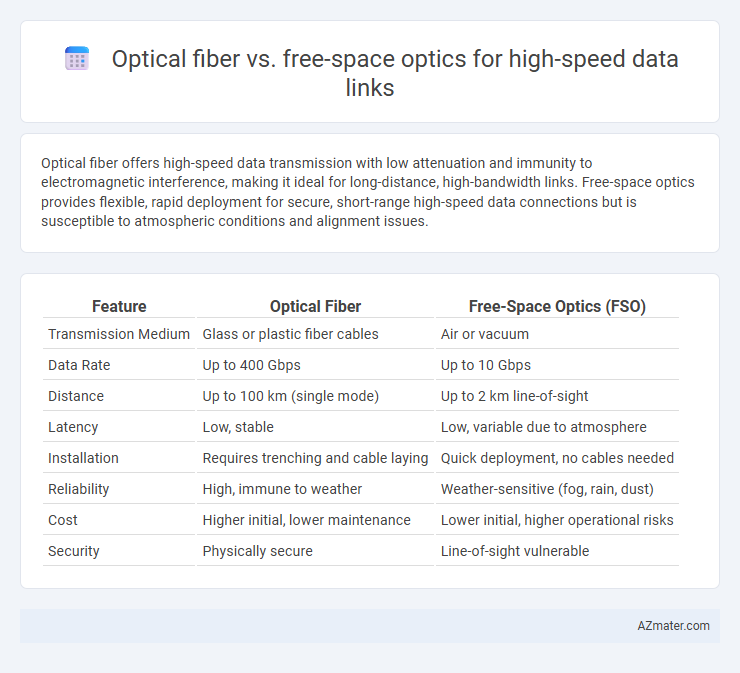Optical fiber offers high-speed data transmission with low attenuation and immunity to electromagnetic interference, making it ideal for long-distance, high-bandwidth links. Free-space optics provides flexible, rapid deployment for secure, short-range high-speed data connections but is susceptible to atmospheric conditions and alignment issues.
Table of Comparison
| Feature | Optical Fiber | Free-Space Optics (FSO) |
|---|---|---|
| Transmission Medium | Glass or plastic fiber cables | Air or vacuum |
| Data Rate | Up to 400 Gbps | Up to 10 Gbps |
| Distance | Up to 100 km (single mode) | Up to 2 km line-of-sight |
| Latency | Low, stable | Low, variable due to atmosphere |
| Installation | Requires trenching and cable laying | Quick deployment, no cables needed |
| Reliability | High, immune to weather | Weather-sensitive (fog, rain, dust) |
| Cost | Higher initial, lower maintenance | Lower initial, higher operational risks |
| Security | Physically secure | Line-of-sight vulnerable |
Introduction: Optical Fiber vs Free-Space Optics
Optical fiber offers high-speed data transmission through glass or plastic fibers with minimal signal loss and exceptional bandwidth capacity, making it ideal for stable, long-distance communication. Free-space optics (FSO) transmits data via light beams through the air, providing flexibility and ease of deployment but experiencing performance variability due to weather conditions and line-of-sight limitations. The choice between optical fiber and FSO depends on factors such as infrastructure costs, environmental conditions, and required link reliability for high-speed data links.
Key Principles of Optical Fiber Communication
Optical fiber communication relies on total internal reflection within a core of glass or plastic to transmit light signals over long distances with minimal loss, enabling high-speed data links. Unlike free-space optics, which use air as the transmission medium and are susceptible to atmospheric disturbances, optical fiber offers superior reliability and bandwidth capacity due to its enclosed structure. Key principles include low attenuation, minimal signal distortion, and high immunity to electromagnetic interference, making optical fiber the preferred choice for stable, high-speed telecommunications networks.
Fundamentals of Free-Space Optical (FSO) Communication
Free-space optical (FSO) communication transmits data via line-of-sight laser beams through the atmosphere, offering high bandwidth and low latency ideal for high-speed data links. Unlike optical fiber, which uses physical cables to guide light pulses, FSO relies on the direct propagation of light in free space, making it vulnerable to atmospheric conditions such as fog, rain, and turbulence. Key FSO components include laser transmitters, photodetector receivers, and precise alignment systems that enable rapid deployment without costly infrastructure.
Bandwidth and Data Rate Capabilities
Optical fiber technology supports ultra-high bandwidths exceeding several terabits per second, enabling continuous and stable high-speed data rates ideal for long-distance communications. Free-space optics (FSO) offer flexible deployment with gigabit-per-second data rates, yet their performance is highly sensitive to atmospheric conditions, limiting consistent high-bandwidth delivery. The intrinsic low attenuation and high-capacity modulation formats in optical fibers provide superior data rate capabilities compared to the variable bandwidth potential of free-space optical links.
Transmission Distance and Signal Attenuation
Optical fiber offers superior transmission distance capabilities exceeding 100 km with minimal signal attenuation typically around 0.2 dB/km for single-mode fibers, making it ideal for long-haul high-speed data links. Free-space optics (FSO) generally supports shorter transmission distances up to a few kilometers due to atmospheric conditions causing signal attenuation ranging from 10 to 30 dB/km, which significantly limits its range and reliability. Despite FSO's rapid deployment advantages, optical fiber remains the optimal choice for high-speed data links requiring long-distance transmission and low attenuation.
Environmental Impact and Reliability
Optical fiber offers superior reliability and minimal environmental impact due to its enclosed infrastructure, which protects it from weather and physical damage, ensuring consistent high-speed data transmission. Free-space optics (FSO) depends heavily on atmospheric conditions like fog, rain, and dust, leading to potential signal degradation and interruptions, thus impacting reliability. The installation of FSO requires no physical cabling, reducing environmental disruption during deployment but can face challenges in maintaining stable links in variable climates.
Installation and Maintenance Considerations
Optical fiber installation requires physical cable laying and careful splicing, demanding skilled labor and causing potential disruptions in urban environments. Free-space optics (FSO) offers rapid deployment without trenching or cable runs, making it ideal for temporary or hard-to-reach links but requires precise alignment and clear line-of-sight for optimal performance. Maintenance of fiber optics involves monitoring cable integrity and protecting against physical damage, whereas FSO systems need regular cleaning of transceivers and environmental adjustments to sustain signal quality in adverse weather conditions.
Cost Efficiency and Budget Analysis
Optical fiber offers lower per-gigabit costs for high-speed data links due to its established infrastructure and durability, resulting in reduced long-term maintenance expenses. Free-space optics (FSO) requires less initial capital investment since it eliminates the need for physical cables but incurs higher costs under adverse weather conditions and limited range. Budget analysis shows optical fiber is more cost-efficient for large-scale, permanent installations, while FSO suits temporary or flexible deployments with moderate budget constraints.
Security and Data Protection
Optical fiber offers superior security for high-speed data links due to its resistance to electromagnetic interference and difficulty to tap without detection, ensuring robust data protection. Free-space optics, while providing flexible deployment, is more vulnerable to interception and environmental disruptions, raising concerns about signal confidentiality. Implementing advanced encryption protocols is essential in free-space optics to mitigate potential security risks and maintain data integrity.
Use Cases and Application Scenarios
Optical fiber excels in high-speed data links for long-distance telecommunications, data center interconnects, and undersea cable networks due to its low signal attenuation and high bandwidth capacity. Free-space optics (FSO) is ideal for urban environments, temporary setups, and areas with challenging infrastructure, enabling rapid deployment of high-speed connections between buildings or remote sites without physical cables. Both technologies support backbone and metro networks, with optical fiber favored for permanent, high-reliability links and FSO chosen for flexible, line-of-sight applications such as disaster recovery and military communications.

Infographic: Optical fiber vs Free-space optics for High-speed data link
 azmater.com
azmater.com